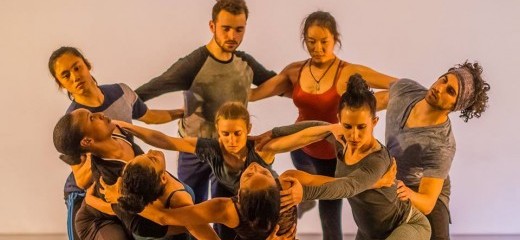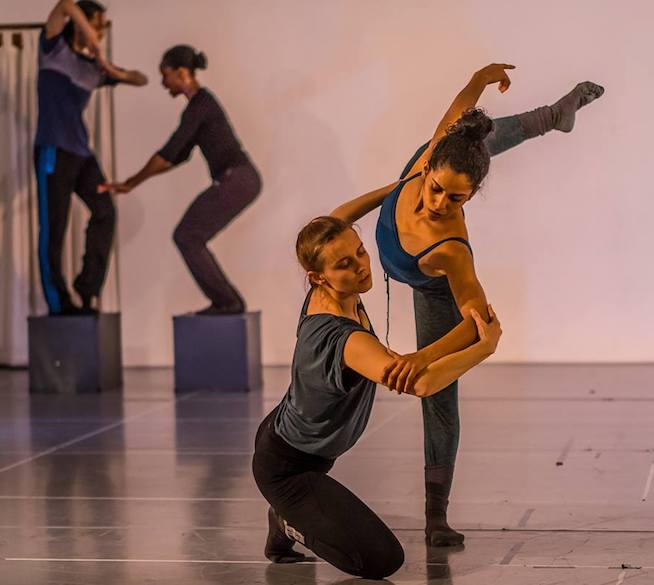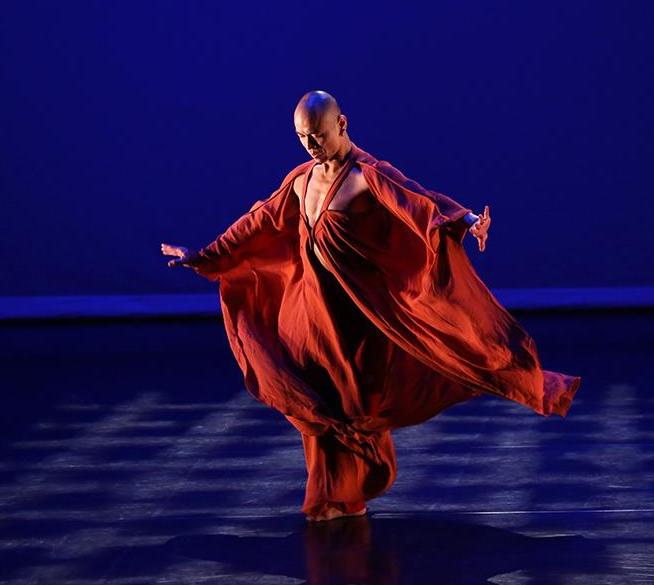
Kun-Yang Lin / Dancers: Occupying The Spaces Between
by Kalila Kingsford Smith
In preparation for their upcoming performance, SANCTUARY, Kun-Yang Lin / Dancers offers a series of in-studio showings that highlight how choreographer Kun-Yang Lin creates his works. These feature excerpts of SANTUARIO, to premiere this month at the Prince Theater, and ONE: Immortal Game, a reimagining of a work that Lin created in 2013. Lin speaks to the audience about his creative process, answers questions, and discusses his philosophy surrounding his choreography and dance technique, which he calls Chi Awareness.
An upbeat song fills the room as the lights rise on a clump of dancers in the upstage corner. Their movements are familiar—I see voguing, whaacking, the robot—they are ever-changing, much like dancing you’d see at a club. Imagining myself in that clump, I don’t mind our closeness, our crowdedness. There is joy there. There is heat.
After each dancer comes forward in a happy display of their personality, the whole group tumbles to the front of the space. They land before the audience in a straight line. Each dancer looks forward, but in a slightly different direction. Their stillness and seriousness is shocking after so much joyous energy. They isolate their heads—sharp little shifts in focus—and I begin to see it, the horror. Each dancer’s eyes tell a different story, but I can tell they are witnessing the same unspeakable event.
Lin developed SANTUARIO as a response to the shooting at the Pulse Nightclub in Orlando. Affected deeply by those events, he asks the question: how does one respond to a horribly heartbreaking event, an attack on one’s personal identity? His answer: counter it with joy. Rather than a retelling of the events at Pulse, SANTUARIO strings together sequences of movement that were created with ‘joy’ in mind and embedded within impulses and images that have taken hold in Lin’s creative mind since the shooting.
The dancers disperse into swirling chaotic phrases. Four emerge as the embodiment of hate: mocking laughter and aggressive postures. They link arms and walk backwards, pressing the remaining dancers into a smaller and smaller clump, bodies scrambling to get out, bodies trapped behind this wall. Imagining myself in that clump, this time I mind our closeness, our crowdedness. There is fear there. There is heat.
Lin mentions that he hopes to lead the audience through the discomfort of these images and into a greater sense of resolve by the end of SANTUARIO. But he also says that there is value in living between the comfortable and the uncomfortable. He embraces the contradiction in the hopes of finding equilibrium. This concept is the basis for Lin’s Chi Awareness technique.

ONE: Immortal Game, Dancers: Liu Mo, Shaness Kemp, Grace Stern, and Keila Pérez-Vega, Photo: Mike Hurwitz
Before showing excerpts from ONE: Immortal Game, Lin passes around two photos. One is the familiar Yin-Yang symbol. The other is a picture of a crowd gathered around a Chinese chess game. The players and the spectators all focus intently on the board. Lin started this process in 2012, when Obama’s reelection was causing political anxiety. This context led him to consider the polarization and often blatant disregard for one’s opponent in the world of political debate. This he contrasted with the competitive, yet respectful, etiquette embedded within a game of chess.
Dancer Liu Mo and guest artist Shaness Kemp approach three wooden cubes at the front of the stage. They dip into a slow bow before sitting cross-legged on two cubes, the third centered between them. Mo slices his arm to the high diagonal, folds it back in, gestures toward the surface of the block, and returns to a neutral position. Kemp gestures similarly, crossing her arm across her chest, rolling her hands around each other and points to the block. At every gesture, they shout words—Kemp repeats, “King. Queen. Bishop. Knight. Rook.” Mo repeats what I assume is the equivalent in Mandarin. They exchange ‘turns’ back and forth a number of times, speeding up and gaining aggression until they end up slicing toward the ‘board’ in near unison. Eventually, they make their final moves, stand, bow towards each other, and exit to opposite sides of the space, the ritual complete.
Presenting these oppositional forces while maintaining a sense of integrity seems to be Lin’s intention for ONE: Immortal Game. Chinese chess is a metaphor for life. It requires strategy—moving with an understanding of your pathway—but it also requires improvisation, as your course could change in response to your opponent’s move. It is concentration, focus, precision, and awareness of both self and other. This is yin-yang. This is Chi Awareness.

Kun-Yang Lin in Mandala, 2013, Photo: Bill Hebert
With a simple walking pattern—step, step, together, turn—we maneuver through each other in a grid-like pathway. There are fifteen students in class, all walking through the space and towards each other. I have to sense my own pathway—deciding which direction I turn. I also have to be aware of the distances between bodies and the relative speeds of the dancers around me in order to avoid any collisions. Internally, this feels like the coexistence of the internal and external, me inside of the community. We are aware of the spaces in-between us.
Though I have been frequenting his class this year, I’m only now starting to understand what Lin means by Chi Awareness as it applies to dance practice. We always begin with an improvisation, moving through more technical exercises before we reach a culminating vigorous combination. Lin calls into focus how we are breathing and how we become the essence of a shape. We are not just dancing solo; we are energizing the space around us. There is resistance and information in those empty spaces. There is no separation between right and left, inhale and exhale, internal and external, positive and negative. It is the coexistence of opposite forces, and the embracing of both. Chi Awareness is about occupying those spaces in between.
At the end of class, we return to the breath, standing in a circle, aware of both our internal energies and the energy of the group. Slowly we move together, sensing each other’s presence, responding to each other’s impulses. We end up in a clump, sensing not by sight but by warmth. We move in and around each other’s empty spaces with delicacy and respect. I am inside this clump, and I don’t mind our closeness, our crowdedness. There is love here. There is heat.
SANCTUARY, Kun-Yang Lin/Dancers, Prince Theater, April 27-29. Tickets: http://princetheater.org/events/kun-yang-lin-dancers/
Pre-Show Encounters, CHI Movement Arts Center, Deconstructing SANTUARIO, March 30, Deconstructing ONE: Immortal Game, April 13.
By Kalila Kingsford Smith
April 23, 2017






.png)


